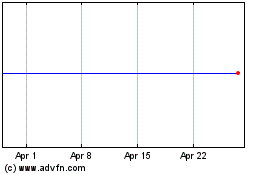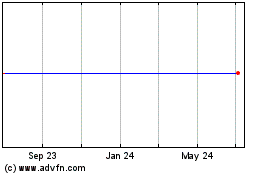US FDA Accepts Regulatory Submission for TAGRISSO (Osimertinib) in 1st-Line EGFR-Mutated Non-Small Cell Lung Cancer
December 18 2017 - 7:00AM
Business Wire
TAGRISSO granted Priority Review; acceptance
follows FDA’s Breakthrough Therapy Designation
AstraZeneca today announced that the US Food and Drug
Administration (FDA) has accepted a supplemental New Drug
Application (sNDA) for the use of TAGRISSO® (osimertinib), a
third-generation, irreversible epidermal growth factor receptor
(EGFR) tyrosine kinase inhibitor (TKI) with clinical activity
against central nervous system (CNS) metastases, in the 1st-line
treatment of patients with metastatic non-small cell lung cancer
(NSCLC) whose tumors have EGFR mutations (exon 19 deletions or exon
21 (L858R) substitution mutations). The FDA has granted TAGRISSO
Priority Review status, and previously granted Breakthrough Therapy
Designation for TAGRISSO in the 1st-line treatment of patients with
metastatic EGFR mutation-positive (EGFRm) NSCLC.
The submission acceptance is based on data from the Phase III
FLAURA trial, in which TAGRISSO significantly improved
progression-free survival (PFS) compared to current 1st-line
EGFR-TKIs, erlotinib or gefitinib, in previously-untreated patients
with locally advanced or metastatic EGFRm NSCLC.
Detailed results of the FLAURA trial can be found in the New
England Journal of Medicine, published November 18, 2017.
On September 28, 2017, the US NCCN Clinical Practice Guidelines
in Oncology (NCCN Guidelines®) were updated to include the use of
TAGRISSO in the 1st-line treatment of patients with locally
advanced or metastatic EGFRm NSCLC. The use of TAGRISSO in this
indication is not yet approved by the FDA.
TAGRISSO once-daily tablets are approved by the FDA for the
treatment of patients with metastatic EGFR T790M mutation-positive
NSCLC, as detected by an FDA-approved test, whose disease has
progressed on or after an EGFR TKI therapy.
TAGRISSO® (osimertinib) Important Safety
Information
- There are no contraindications for
TAGRISSO
- Interstitial Lung Disease
(ILD)/Pneumonitis occurred in 3.5% and was fatal in 0.6% of 833
TAGRISSO-treated patients. Withhold TAGRISSO and promptly
investigate for ILD in patients who present with worsening of
respiratory symptoms indicative of ILD (e.g., dyspnea, cough,
and fever). Permanently discontinue TAGRISSO if ILD is
confirmed
- Heart rate-corrected QT (QTc) interval
prolongation occurred in TAGRISSO-treated patients. Of the 833
TAGRISSO-treated patients, 0.7% of patients were found to have a
QTc > 500 msec, and 2.9% of patients had an increase from
baseline QTc > 60 msec. No QTc-related arrhythmias were
reported. Conduct periodic monitoring with ECGs and electrolytes in
patients with congenital long QTc syndrome, congestive heart
failure, electrolyte abnormalities, or those who are taking
medications known to prolong the QTc interval. Permanently
discontinue TAGRISSO in patients who develop QTc interval
prolongation with signs/symptoms of life-threatening
arrhythmia
- Cardiomyopathy occurred in 1.9% and was
fatal in 0.1% of 833 TAGRISSO-treated patients. Left Ventricular
Ejection Fraction (LVEF) decline ≥ 10% and a drop to < 50%
occurred in 4% of 655 TAGRISSO-treated patients. Conduct cardiac
monitoring, including an assessment of LVEF at baseline and during
treatment in patients with cardiac risk factors. Assess LVEF in
patients who develop relevant cardiac signs or symptoms during
treatment. For symptomatic congestive heart failure or persistent,
asymptomatic LV dysfunction that does not resolve within 4 weeks,
permanently discontinue TAGRISSO
- Keratitis was reported in 0.7% of 833
TAGRISSO-treated patients in clinical trials. Promptly refer
patients with signs and symptoms suggestive of keratitis (such as
eye inflammation, lacrimation, light sensitivity, blurred vision,
eye pain, and/or red eye) to an ophthalmologist
- Advise pregnant women of the potential
risk to a fetus. Advise females of reproductive potential to use
effective contraception during TAGRISSO treatment and for 6 weeks
after the final dose. Advise males with female partners of
reproductive potential to use effective contraception for 4
months after the final dose
- The most common adverse reactions
(≥20%) in patients treated with TAGRISSO were diarrhea (41%), rash
(34%), dry skin (23%), nail toxicity (22%), and fatigue (22%)
Please see complete Prescribing
Information including Patient Information.
-ENDS-
NOTES TO EDITORS
About Non-Small Cell Lung Cancer (NSCLC)Lung cancer is
the leading cause of cancer death among both men and women,
accounting for about one-quarter of all cancer deaths, more than
breast, prostate and colorectal cancers combined. Approximately 7%
to 23% in Western populations and 30% to 50% of patients in Asian
populations have tumors that contain activating mutations in
epidermal growth factor receptor (EGFR). These patients are
particularly sensitive to treatment with currently available EGFR
tyrosine kinase inhibitors (TKIs), which block the cell-signaling
pathways that drive the growth of tumor cells. However, tumors
almost always develop resistance to EGFR-TKI treatment, leading to
disease progression. Approximately half of patients develop
resistance to approved EGFR-TKIs such as gefitinib and erlotinib
due to the resistance mutation, EGFR T790M. TAGRISSO also
targets this secondary mutation that leads to disease progression.
There is also a need for medicines with improved central nervous
system efficacy, since approximately 25% of patients with
EGFR-mutated NSCLC have brain metastases at diagnosis, increasing
to approximately 40% within two years of diagnosis.
About TAGRISSO®
(osimertinib)TAGRISSO® (osimertinib) is a
third-generation, irreversible epidermal growth factor receptor
(EGFR) tyrosine kinase inhibitor (TKI) designed to inhibit both
EGFR sensitizing and EGFR T790M resistance mutations, with clinical
activity against central nervous system (CNS)
metastases. TAGRISSO 40mg and 80mg once-daily oral tablets
have been approved in more than 60 countries, including the US, EU,
Japan and China, for patients with EGFR T790M mutation-positive
advanced non-small cell lung cancer.
TAGRISSO is also being investigated in the adjuvant setting and
in combination with other treatments.
About the FLAURA trialThe FLAURA trial assessed the
efficacy and safety of osimertinib 80mg once daily vs
standard-of-care epidermal growth factor receptor (EGFR) tyrosine
kinase inhibitors (TKIs) (either erlotinib [150mg orally, once
daily] or gefitinib [250mg orally, once daily]) in
previously-untreated patients with locally advanced or metastatic
EGFR mutation-positive non-small cell lung cancer. The trial was a
double-blinded, randomized trial, with 556 patients across 29
countries.
About AstraZeneca in Lung CancerAstraZeneca is committed
to developing medicines to help every patient with lung cancer. We
have two approved medicines and a growing pipeline that targets
genetic changes in tumor cells and boosts the power of the immune
response against cancer. Our unrelenting pursuit of science aims to
deliver more breakthrough therapies with the goal of extending and
improving the lives of patients across all stages of disease and
lines of therapy.
About AstraZeneca in OncologyAstraZeneca has a
deep-rooted heritage in Oncology and offers a quickly growing
portfolio of new medicines that has the potential to transform
patients’ lives and the Company’s future. With at least six new
medicines to be launched between 2014 and 2020, and a broad
pipeline of small molecules and biologics in development, we are
committed to advance New Oncology as one of AstraZeneca’s five
Growth Platforms focused on lung, ovarian, breast and blood
cancers. In addition to our core capabilities, we actively pursue
innovative partnerships and investments that accelerate the
delivery of our strategy, as illustrated by our investment in
Acerta Pharma in hematology.
By harnessing the power of four scientific platforms –
Immuno-Oncology, Tumor Drivers and Resistance, DNA Damage Response
and Antibody Drug Conjugates – and by championing the development
of personalized combinations, AstraZeneca has the vision to
redefine cancer treatment and one day eliminate cancer as a cause
of death.
About AstraZenecaAstraZeneca is a global, science-led
biopharmaceutical company that focuses on the discovery,
development and commercialization of prescription medicines,
primarily for the treatment of diseases in three therapy areas –
Oncology, Cardiovascular & Metabolic Diseases and Respiratory.
The Company also is selectively active in the areas of
autoimmunity, neuroscience and infection. AstraZeneca operates in
over 100 countries and its innovative medicines are used by
millions of patients worldwide. For more information, please visit
www.astrazeneca-us.com and follow us on Twitter @AstraZenecaUS.
US-15760 Last Updated 12/17
View source
version on businesswire.com: http://www.businesswire.com/news/home/20171218005480/en/
AstraZenecaMichele Meixell, +1-302-885-2677orAbby Bozarth,
+1-302-885-2677
AstraZeneca (NYSE:AZN)
Historical Stock Chart
From Mar 2024 to Apr 2024

AstraZeneca (NYSE:AZN)
Historical Stock Chart
From Apr 2023 to Apr 2024
